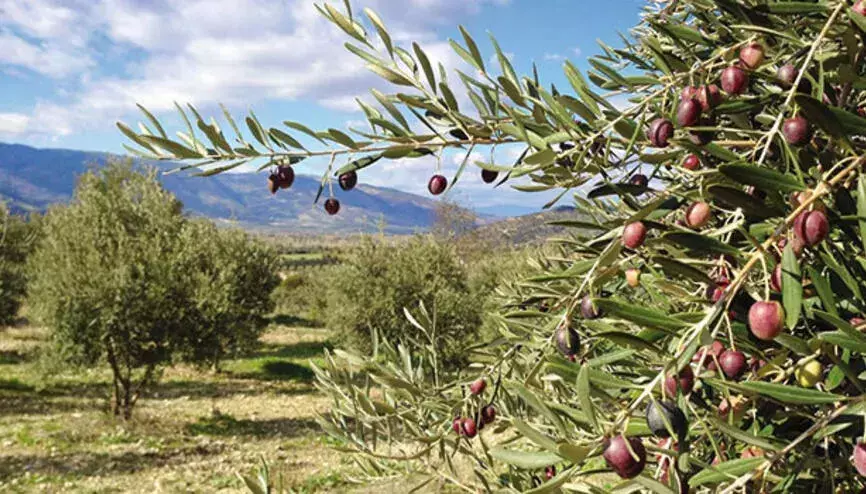Olive oil, a staple of Mediterranean culture and cuisine, is facing an unprecedented environmental threat. A new scientific study published this month in Communications Earth & Environment reveals that growing water stress and a projected decline in solar activity could severely undermine olive production across the Mediterranean—home to more than 98% of the world’s supply.
The research, led by an international team of scientists, used 8,000 years of fossil pollen records to reconstruct the history of olive tree productivity and examine the long-term factors shaping yields. The findings suggest that changes in temperature, rainfall, and solar radiation will reduce the resilience of olive groves—especially in arid and semi-arid regions—posing serious challenges to farmers and economies that depend on olive cultivation.
“Most studies focus on short-term climate variability. What we’re showing is that there are long-term climatic rhythms—including solar cycles—that have shaped olive productivity over millennia. These cycles are now being disrupted,” said lead author Samuel Luterbacher, a climate scientist at the University of Giessen in Germany.
Olive Groves on the Edge
The study identifies three key climatic drivers of olive productivity: photosynthesis, water availability, and solar irradiance. These factors collectively determine the trees’ ability to flower and bear fruit. Researchers found that historical periods of drought and low solar activity were strongly correlated with sharp declines in olive pollen—used as a proxy for fruit yield.
Drawing on data from across the Mediterranean—including Syria, Palestine, Turkey, Greece, Italy, and Spain—the team modelled past climate impacts and projected them into the future. The results are sobering: as global temperatures rise and precipitation patterns shift, olive trees will likely face increased water stress, particularly during sensitive stages like flowering and fruiting.
Adding to the concern, the study warns that the sun may be entering a new “grand solar minimum”—a prolonged period of reduced solar radiation. The last such event, the Maunder Minimum in the 17th century, coincided with the Little Ice Age, a time of global cooling and agricultural disruption.
A decline in solar activity would reduce energy available for photosynthesis, further affecting olive yields. This combination of environmental stressors—drought and diminished sunlight—creates what researchers call a “perfect storm” that could devastate olive agriculture across the region.
A Cultural and Economic Crisis in the Making
The implications extend well beyond agriculture. Olive oil is not only a nutritional cornerstone but also an economic lifeline in countries like Spain, Italy, Greece, and Tunisia. According to the International Olive Council, over 6.7 million families depend on olive farming for their livelihoods.
Egypt, while not yet among the top producers, has expanded olive cultivation in recent years—particularly in desert reclamation zones. However, experts warn that this strategy may be at risk if water resources become more strained under a changing climate.

“This research underscores the urgency of adapting our agricultural practices,” said Mohamed Dawood, an Egyptian agricultural engineer specializing in arid land farming. “In Egypt, many of our new olive plantations are in marginal lands where water efficiency is already a challenge. If the climate becomes drier and solar radiation declines, yields will suffer unless we change how we manage irrigation and soil health.”
The study urges a fundamental rethink in olive grove management. Among the key recommendations: investing in drought-resilient cultivars, enhancing soil moisture retention strategies, and reassessing where olives can viably be grown in the future.
The Climate Clock Is Ticking
This research arrives amid mounting climate disruptions. Across the Mediterranean, extreme heatwaves and shifting rainfall patterns have already begun to impact crop yields. In 2023, Spain—one of the world’s largest olive oil producers—suffered a 50% drop in production due to severe drought.
“This is not just a warning about the distant future,” said co-author Ines Álvarez of the University of Jaén in Spain. “We are already seeing the effects of climate change on olive groves. What our study adds is a deeper understanding of the natural cycles that have supported olive production for thousands of years—and how these cycles are being thrown off balance.”
The authors argue that national and regional policies must urgently support sustainable water use, biodiversity preservation, and a reduction in greenhouse gas emissions to safeguard the future of olive production.
For Egypt—positioning itself as a future hub for olive oil production and exports—this could be a pivotal moment to embrace climate-smart agriculture. As olive trees across the Mediterranean quietly signal distress, the message is clear: the region’s liquid gold is in danger, and time is running out.




